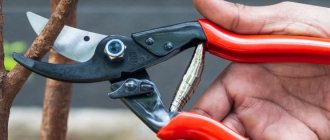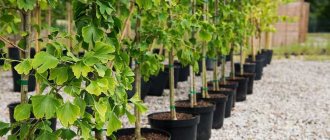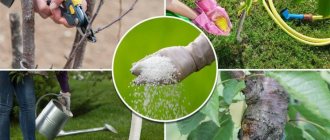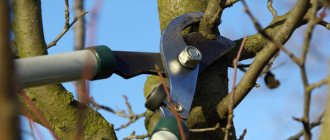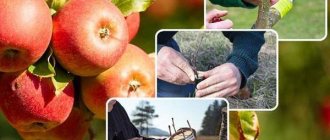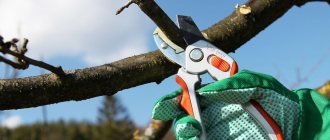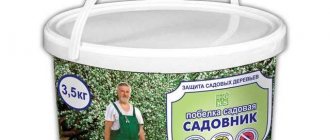To have a beautiful and blooming garden, you need to devote time to it and properly care for the trees and bushes. Then you can always enjoy the pleasant aroma of fruits grown yourself. To care for the garden, you will need to buy several tools, one of which is considered to be a high-quality pruner for grafting trees. It helps in the formation of ornamental bushes, promotes the proper development of plants, allows for the necessary vaccinations, and improves their nutrition. Let's figure out which tool is better to buy, how to use it, and how the device will help in gardening.
Knives for grafting fruit trees
To carry out the procedure, a regular knife will not work; you need to purchase a special one for gardening work. They come in several varieties:
- Garden knife. It is often used when working with fruit trees, but it is better suited for cutting cuttings and treating wounds. For grafting, it is better to buy a special knife.
- Budding knife. Indispensable when carrying out budding, when grafting with a kidney. The knife has a concave-convex blade with a sharp end and a special protrusion for conveniently pushing apart the tree bark.
- Copulating knife. Suitable for grafting with cuttings. The blade is straight, it is very convenient for them to make an even and long cut.
Note. The copulating knife requires sharpening only on one side.
When purchasing any tool for gardening work, you must choose a tree grafting tool made from quality material. Carbon steel is ideal for these purposes.
How to use pruning shears to graft trees
Grafting apple trees with pruning shears or other trees is as follows:
- We make 2 mirror cuts with a tool (using the rootstock and scion). On the rootstock it is performed with the internal direction, on the scion - with the external direction.
- Unclench the pruning shears so that the knife releases the trunk.
- We connect the two parts, preventing the bark from separating.
- The place of fastening is wrapped with turns of grafting tape, making it “tight”.
At the end, damaged areas on the trees are treated with garden varnish.
We also suggest watching a video of the entire process, how grafting with grafting pruners occurs.
How to make tree grafting pruners last a long time
In order for the tool to last as long as possible, it is necessary to properly care for the device. After completing all work, you need to remove plant debris from the blade. It is not recommended to wash the product, as this will dull the blades.
Pay special attention to the spring with the fixation bracket. Wipe the structure with a dry textile cloth, and then treat with oil or astringent. These manipulations must be done after each use. It is regularly recommended to sharpen the blades so that the knives do not damage the branches.
A reliable pruner for grafting trees is an important thing in a gardener's arsenal. By choosing a good tool and carefully caring for it, the device will become a reliable assistant in gardening work.
Types of secateurs
Another necessary tool is a pruning shears. It allows you to perform a large amount of work with fruit trees, removing excess branches and shortening shoots. To choose pruning shears, you need to get acquainted with their variety:
- Bypass pruner. The working blade has a slight offset relative to the cutting line. This allows you to make them even, causing minimal damage to the tree.
- Secateurs with anvil. Excellent for cutting dry and damaged branches due to the absence of a blade offset line.
- Ratchet Tool. Suitable for trimming any branches, including old and thick ones. Secateurs are easy to use and require minimal effort during operation. The pruning procedure can be performed in several stages. These pruning shears are convenient for female representatives to use.
- Grafting pruner. Ideal for grafting not only fruit trees, but also grapes and rose bushes. There are three nozzles.
What types of grafting knives are there?
This agricultural tool exists in three versions, depending on what grafting methods are used:
- Budding - with this method, transplantation is carried out using a bud or cutting, called budding. Hence the name of the instrument. To carry out budding according to all the rules, you need to make a T-shaped section, then bending the edges of the bark. Moreover, it is necessary to bend the edges without touching with your hands, only with a blade, in order to maintain the sterility of the process. Accordingly, the blade of the weapon must be curved, having a double-sided sharpening.
- Cuttings - for this method of transplantation it is necessary to cut the cuttings. Accordingly, the tool is called a cutting or copulating tool. To reduce the risk of injury, the end of the blade is rounded, and the type of working blade with one-sided sharpening is straight, without bends. Such knives are also called cleavers or cleavers, as they allow you to literally chop cuttings.
- Universal - these types are made either like a penknife, a Swiss knife, with two blades, or a hybrid form, one working surface is straight-shaped, the second is sickle-shaped. The latter types of tools are less common due to less operating comfort and a greater chance of injury.
There is constant debate among amateur gardeners regarding equipment for grafting and budding - which is the best tool to buy, a pruner or a knife?
The advantages of pruning shears are high speed of operation, lower risks of injury, and longer service life. True, the last factor is true if the pruning shears are equipped with replaceable blades. Thus, popular models of pruning shears have a set of replaceable working surfaces. Which, naturally, increases the average price of pruning shears. Also, the grafting pruner does not require selection skills, since the sections are optimally adjusted to each other. The main disadvantage of pruning shears is squeezing the cuttings. This is important if the criteria for choosing a tool are processing trees and hardwood shrubs. “Above” knives, secateurs and in price. In addition, grafting pruners have restrictions on the thickness of the rootstock and scion. Garden knives do not have such restrictions. He considers the simplicity of maintenance to be a plus, for example, the ability to sharpen the blade yourself. What will be discussed below. But the problem of how to work with a sharpened blade remains relevant.
What to look for when choosing a grafting cleaver
Since copulation and budding methods of selection are equally common, it is best for the gardener to have two appropriate tools. It is not recommended to purchase universal models. If we talk about tools whose blades have two types of shapes, then such blades are dangerous when working. The pen-type options are inconvenient. After all, the handle of such a knife weighs more and has worse ergonomics. In addition, the spring that holds the blades in the handle-case weakens over time, causing the functionality to drop to zero. Separately, the ergonomics of the handle mentioned above should be mentioned.
The breeder, as a rule, works with gloves, plus it must be taken into account that for rootstocks with a thickness of over 7 mm, a certain force applied to the tool is required. Therefore, the handle should be comfortable, wear-resistant, and shockproof. And the wider and longer the working blade, the heavier the handle should be. But special attention should be paid to the blade. After all, during selection, the cut of the rootstock or scion should be uniform, without damage or peeling of the woody structure. Otherwise, the damaged areas will become hotbeds for the development of a fungal culture. As a result, not only the scion, but also the rootstock may die. That is, the agricultural crop itself. Therefore, the canvas must have a maximum degree of polishing over the entire area.
It is unacceptable for the blade to have roughness, protrusions, or even a chip in it anywhere. According to the blade, the sharpening of the grafting knife must be ideal. It should be as sharp and polished as possible. The sharpening angle may depend on the manufacturer of the tool. Thus, Chinese-made products have a blade sharpening range of 15-20 degrees. Since the times of the USSR, the domestic GOST prescribes an angle of 14-18 degrees. Taking into account the requirements for strength, smoothness of the working surface, and also taking into account the need for constant sharpening, the material for the blade is selected from steel alloys with a carbon content above 0.6%, with a thickness of 1.5-2 mm. This type of steel is wear-resistant, easy to polish, but low-viscosity. Which causes increased fragility.
Additional accessories increase the functionality of such equipment. For example, a plastic or steel petal with the function of separating the scion bark. Taking into account the general, increased requirements for the instrument, we must remember about care. Therefore, it is prohibited to use the grafting knife for other purposes. Given the toughness of steel, it is best to purchase a pair of knives for each selection method for different thicknesses of planting material. During storage and operation, the greatest attention is paid to the sharpness of the blade. There are step-by-step instructions on the Internet on how to sharpen a breeding cleaver with your own hands. But when sharpening with your own hands, especially for the first time, it is easy to make a mistake. Therefore, it is best to entrust the process of sharpening and polishing to a specialist.
Inevitably, over time, the question arises: is it possible to make a selection tool yourself, at home? It is difficult to answer this question unambiguously. On the one hand, thematic groups and forums are full of advice on how to make a homemade instrument; there are also step-by-step instructions. But even if you manage to find steel of the required hardness, you need to accurately replicate the ergonomics of the handle, sharpen, and polish the blade. And even in this case, it will be possible to make a model only for rootstocks of small thickness.
Which company is better to buy?
To avoid mistakes when choosing a tool and to protect plants from death, you should only trust a trusted manufacturer. The best manufacturers of garden tools, according to buyers, today are:
- German: Graft Pro, Solingen, Raco, Tina;
- Finnish: Fiskars;
- Italian: Due Buoi;
- Swiss: Victorinox;
- Domestic: Ageev.
How to choose a grafting pruner?
The main working components in this tool are: handle, blade and spring. When purchasing, you need to pay close attention to them:
- The blade should be made of alloy steel and have a chrome or Teflon coating on top.
- Handles should be metal with rubber coating or reinforced plastic. Ordinary plastic handles will quickly crack under heavy load during operation.
- The ease of movement of the pruning shears and the speed of return to its original position depend on the quality of the spring. You can purchase coil springs and tape springs. The first option is cheaper, but the second will provide work for a long time.
Grafting pruner - what kind of device is it?
Plant grafting is the joining of two shoots of different plants through cuts on them. Precise cuts and their perfect alignment without additional adjustment increase the likelihood of fusion. You can use special grafting knives or a special tool. Grafting secateurs are a specific type of secateurs, differing in mechanisms:
- planar - the blades move towards each other in one plane, sharpened on one side;
- contact – double-sided sharpening.
It is distinguished by an unusual design of blades, which allows it to perform the main function - grafting: making even, neatly matching cuts on the rootstock and scion. The grafting pruner is suitable for most fruit trees, grapes, roses and other berry crops. With its help, it is easier and more convenient to carry out the procedure on country crops. Grafting allows you to grow crops even in areas where conditions are not favorable for them.
All pruners are divided according to their intended purpose:
- professional – made of high-carbon steel, work with branches up to 1.5 cm, perform a large number of operations, and are distinguished by increased dimensions;
- amateur - for a small number of procedures, shoots less than 1.3 cm thick, inferior in quality, inexpensive, small in size;
- counterfeits of well-known brands - cheap, not durable.
If you do not plan to graft plants often, there are not many crops on the site, and the budget is limited, then an amateur model is suitable. A professional tool is more expensive, but it is capable of making up to three thousand cuts, which will allow it to be used for a long time.
Additional equipment for vaccination
In addition to garden shears and pruning shears, the following equipment will be required for gardening and plant grafting:
- Garden saw. It is better with a canvas about 35 cm long, having a crescent shape.
- Strapping material : electrical tape, polyethylene film, bast fiber.
- Wound treatment products. The grafting site and fresh cuts must be lubricated with garden varnish in order to prevent infection and speed up engraftment. Plasticine will also work.
If mass grafting is carried out in the garden, then you cannot do without special labels that will allow you not to get confused with the cuttings. You can buy them ready-made or easily make them yourself from available materials: cardboard, plastic cups and a marker.
Rating of the best professional models
The rating of professional models, compiled on the basis of customer demand, will help you choose the best garden grafting pruner for the job:
- Frut 401000: set includes 3 blades, maximum cutting diameter 2 cm, titanium coating of blades, handles covered with plastic, blade lock for storage, Chinese brand, price 1239 RUR;
- Artitec Manual Grafting 3T: made in Italy, in addition to 3 blades, the set includes a special nozzle and a knife for grafting a bud, a cut of up to 1.1 cm, steel blades with a contact mechanism, plastic handles, price 4100 rubles;
- DUE BUOI 300/21: manufactured by the Italian company Alvaro Bernadoni, 2 types of blades, leaf-type spring, ideal sharpening of forged blades, cut up to 1.2 cm, price 4599 rubles;
- Professional Grafting Tool (Belarus): 1 knife with double-sided sharpening, interchangeable with different tools, galvanized zinc coating of the cutting blade, removable handles made of corrugated flexible plastic, lightweight - 0.4 kg, convenient for women to use, easy to repair and adjust, price 2000 rubles .
Rules for using garden tools
The key to successful grafting lies not only in purchasing high-quality material and tools, but also in using them correctly. The following recommendations can be given to beginning gardeners:
- When purchasing, pay attention not to the cost of the equipment, but to the quality of workmanship and material.
- Before using garden knives, they must be sharpened well; this also applies to those just purchased from a specialized store.
- During use, movements should be directed towards you, with the thumb acting as a support. This will allow you to get even and correct cuts.
Note. When working with any tool, be sure to follow safety rules so as not to injure yourself.
A good tree grafting tool is the first step to a successful procedure. Dull knives and unsuitable pruning shears damage the scion and rootstock, making it difficult to establish and seriously injuring fruit trees.


